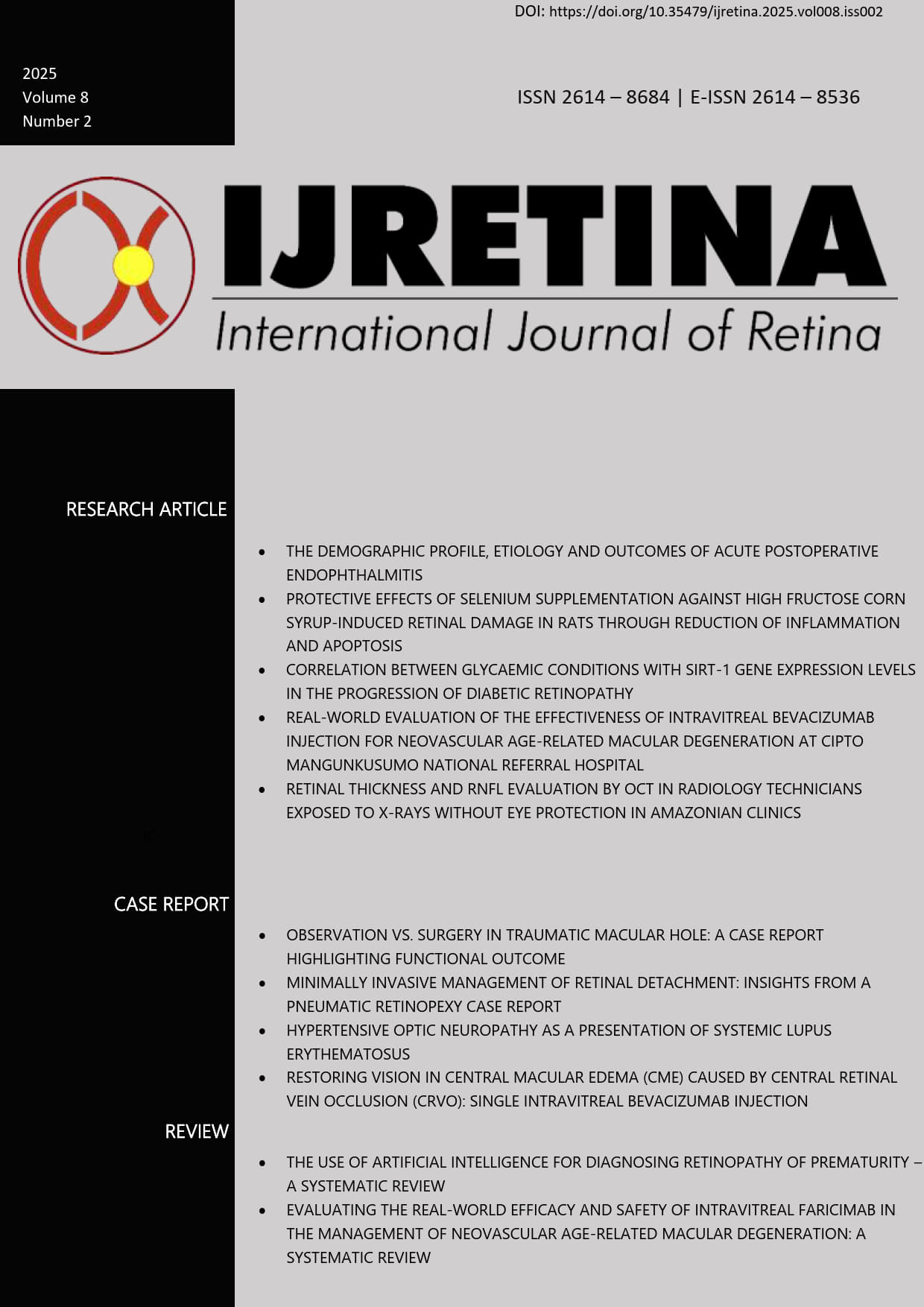Evaluating the Real-World Efficacy and Safety of Intravitreal Faricimab in the Management of Neovascular Age-Related Macular Degeneration: A Systematic Review
Main Article Content
Abstract
Introduction: Neovascular age-related macular degeneration (nAMD) is a leading cause of irreversible vision loss in the elderly. Intravitreal anti-vascular endothelial growth factor (anti-VEGF) therapies have revolutionized the treatment of nAMD. Faricimab, a novel bi-specific anti-VEGF and anti-angiopoietin-2 antibody, has shown promise in clinical trials. This comprehensive systematic review aims to evaluate the real-world efficacy and safety of intravitreal faricimab in the management of nAMD.
Methods: A comprehensive search was conducted in major electronic databases to identify studies reporting outcomes related to faricimab treatment for nAMD in real-world settings. A total of 6 studies were included, comprising 800 patients including 874 eyes. The primary outcomes of interest included visual acuity improvements, central subfield thickness of retina, and safety.
Result: The review reveals that intravitreal faricimab is associated with significant visual acuity improvements in patients with nAMD, with outcomes comparable to or better than existing anti-VEGF agents. Furthermore, patients receiving faricimab typically required fewer injections, resulting in a potentially lower treatment burden. The findings also suggest that faricimab may offer a longer treatment interval, which could have a positive impact on patient quality of life.
Conclusion: Regarding safety, faricimab demonstrated a favorable safety profile in the real-world setting, with a low incidence of ocular and systemic adverse events. This suggests that faricimab is well-tolerated by patients, supporting its long-term use in the management of nAMD.
Keywords
Faricimab, efficacy, neovascular age-related macular degeneration, real-world study, safety
Article Details

This work is licensed under a Creative Commons Attribution-NonCommercial 4.0 International License.
References
2. Gheorghe A, Mahdi L, Musat O. Age-related macular degeneration. Romanian J Ophthalmol. 2015 Jun;59(2):74–7.
3. Deng Y, Qiao L, Du M, Qu C, Wan L, Li J, et al. Age-related macular degeneration: epidemiology, genetics, pathophysiology, diagnosis, and targeted therapy. Genes Dis. 2022 Jan;9(1):62–79.
4. Hobbs SD, Pierce K. Wet age-related macular degeneration (Wet AMD) [Internet]. StatPearls. 2022 [cited 2023 Oct 12]. Available from: https://www.ncbi.nlm.nih.gov/books/NBK572147/
5. Alexandru MR, Alexandra NM. Wet age-related macular degeneration management and age-related Rom J Ophthalmol. 2016 Mar;60(1):9–13.
6. Desideri LF, Traverso CE, Nicolo M, Munk MR. Faricimab for the treatment of diabetic macular edema and neovascular age-related macular degeneration. Pharmaceutics. 2023 May;15(5):1413.
7. Helotera H, Kaarniranta K. A Linkage between angiogenesis and inflammation in neovascular age-related macular degeneration. Cells. 2022;11.
8. Matsumoto H, Hoshino J, Nakamura K, Nagashima T, Akiyama H. Short-term outcomes of intravitreal faricimab for treatment-naïve neovascular age-related macular degeneration. Graefes Arch Clin Exp Ophthalmol. 2023;261:2945–52.
9. Khanani AM, Aziz AA, Khan H, Gupta A. The real-world efficacy and safety of faricimab in neovascular age-related macular degeneration: the TRUCKEE study – 6 month results. Eye [Internet]. 2023; Available from: https://doi.org/10.1038/s41433-023-02553-5
10. Leung EH, Oh DJ, Alderson SE, Bracy J. Initial real-world experience with faricimab in treatment-resistant neovascular age-related macular degeneration. Clin Ophthalmol. 2023;17:1287–93.
11. Inoda S, Takahashi H, Takahashi R, Hashimoto Y. Visual and anatomical outcomes after initial intravitreal faricimab injection for neovascular age-related macular degeneration in patients with prior treatment history. Ophthalmol Ther. 2023;12(5):2703-2712.
12. Mukai R, Kataoka K, Tanaka K, Miyara Y. Three-month outcomes of faricimab loading therapy for wet age-related macular degeneration in Japan. Sci Rep. 2023;13(8747).
13. Szigiato, A, Mohan N, Talcott KE, Mammo DA. Short term outcomes of faricimab in patients with neovascular age related macular degeneration on prior anti-VEGF therapy. Ophthalmol Retina [Internet]. 2023; Available from: https://doi.org/10.1016/j.oret.2023.08.018.
14. Liberski S, Wichrowska M, Kociecki J. Aflibercept versus faricimab in the treatment of neovascular age-related macular degeneration and diabetic macular edema: A Review. Int J Mol Sci. 2023;23(9424).
15. Heier J, Khanani AM, Ruiz CQ, Basu K. Efficacy, durability, and safety of intravitreal faricimab up to every 16 weeks for neovascular age-related macular degeneration (TENAYA and LUCERNE): two randomised, double-masked, phase 3, non-inferiority trials. Lancet. 2022;399:729–40.
16. Mori R, Honda S, Gomi F, Tsujikawa A. Efficacy, durability, and safety of faricimab up to every 16 weeks in patients with neovascular age-related macular degeneration: 1-year results from the Japan subgroup of the phase 3 TENAYA trial. Jpn J Opthalmol. 67(3):301–10.
17. Sahni J, Patel S, Dugel P, Osborne A. Simultaneous inhibition of angiopoietin-2 and vascular endothelial growth factor-a with faricimab in diabetic macular edema BOULEVARD Phase 2 Randomized Trial. Am Acad Opthalmology. 2019;126(8):1155–70.
18. Ciulla TA, Huang F, Westby K, Williams DF, Zaveri S, Patel SC. Real-world outcomes of anti-vascular endothelial growth factor therapy in neovascular age-related macular degeneration in the United States. Ophthalmol Retina. 2018 Jul;2(7):645-653.
19. Inc. PLDP. ELELYSO – Highlights of prescribing information. 2012;7–23. Available from: http://labeling.pfizer.com/ShowLabeling.aspx?id=798
20. Meer EA, Oh DH, Brodie FL. Time, and distance cost of longer acting anti-VEGF therapies for macular degeneration: contributions to drug cost comparisons. Clin Ophthalmol. 2022;16:4273–9.

